Input interpretation

NaOH sodium hydroxide + N_2O_5 dinitrogen pentoxide ⟶ H_2O water + NaNO_3 sodium nitrate
Balanced equation
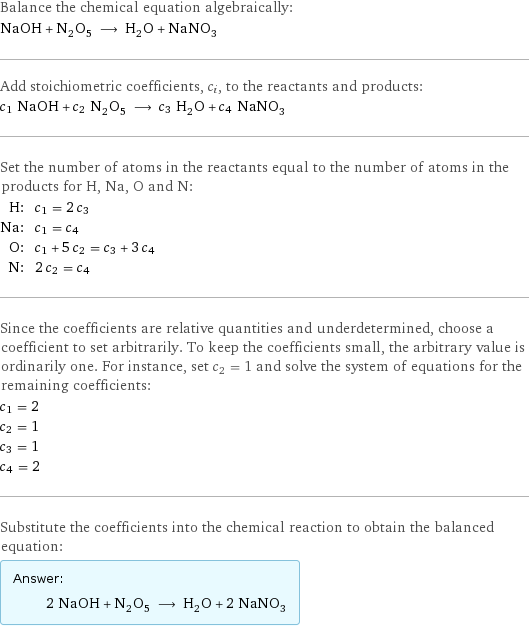
Balance the chemical equation algebraically: NaOH + N_2O_5 ⟶ H_2O + NaNO_3 Add stoichiometric coefficients, c_i, to the reactants and products: c_1 NaOH + c_2 N_2O_5 ⟶ c_3 H_2O + c_4 NaNO_3 Set the number of atoms in the reactants equal to the number of atoms in the products for H, Na, O and N: H: | c_1 = 2 c_3 Na: | c_1 = c_4 O: | c_1 + 5 c_2 = c_3 + 3 c_4 N: | 2 c_2 = c_4 Since the coefficients are relative quantities and underdetermined, choose a coefficient to set arbitrarily. To keep the coefficients small, the arbitrary value is ordinarily one. For instance, set c_2 = 1 and solve the system of equations for the remaining coefficients: c_1 = 2 c_2 = 1 c_3 = 1 c_4 = 2 Substitute the coefficients into the chemical reaction to obtain the balanced equation: Answer: | | 2 NaOH + N_2O_5 ⟶ H_2O + 2 NaNO_3
Structures

+ ⟶ +
Names

sodium hydroxide + dinitrogen pentoxide ⟶ water + sodium nitrate
Reaction thermodynamics
Enthalpy
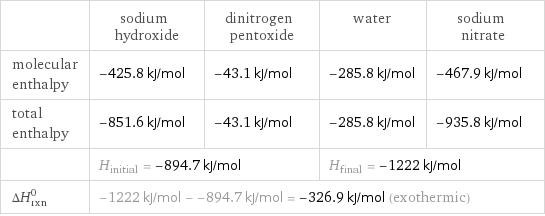
| sodium hydroxide | dinitrogen pentoxide | water | sodium nitrate molecular enthalpy | -425.8 kJ/mol | -43.1 kJ/mol | -285.8 kJ/mol | -467.9 kJ/mol total enthalpy | -851.6 kJ/mol | -43.1 kJ/mol | -285.8 kJ/mol | -935.8 kJ/mol | H_initial = -894.7 kJ/mol | | H_final = -1222 kJ/mol | ΔH_rxn^0 | -1222 kJ/mol - -894.7 kJ/mol = -326.9 kJ/mol (exothermic) | | |
Gibbs free energy
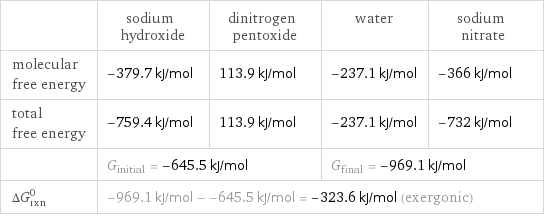
| sodium hydroxide | dinitrogen pentoxide | water | sodium nitrate molecular free energy | -379.7 kJ/mol | 113.9 kJ/mol | -237.1 kJ/mol | -366 kJ/mol total free energy | -759.4 kJ/mol | 113.9 kJ/mol | -237.1 kJ/mol | -732 kJ/mol | G_initial = -645.5 kJ/mol | | G_final = -969.1 kJ/mol | ΔG_rxn^0 | -969.1 kJ/mol - -645.5 kJ/mol = -323.6 kJ/mol (exergonic) | | |
Entropy

| sodium hydroxide | dinitrogen pentoxide | water | sodium nitrate molecular entropy | 64 J/(mol K) | 178 J/(mol K) | 69.91 J/(mol K) | 116 J/(mol K) total entropy | 128 J/(mol K) | 178 J/(mol K) | 69.91 J/(mol K) | 232 J/(mol K) | S_initial = 306 J/(mol K) | | S_final = 301.9 J/(mol K) | ΔS_rxn^0 | 301.9 J/(mol K) - 306 J/(mol K) = -4.09 J/(mol K) (exoentropic) | | |
Equilibrium constant
![Construct the equilibrium constant, K, expression for: NaOH + N_2O_5 ⟶ H_2O + NaNO_3 Plan: • Balance the chemical equation. • Determine the stoichiometric numbers. • Assemble the activity expression for each chemical species. • Use the activity expressions to build the equilibrium constant expression. Write the balanced chemical equation: 2 NaOH + N_2O_5 ⟶ H_2O + 2 NaNO_3 Assign stoichiometric numbers, ν_i, using the stoichiometric coefficients, c_i, from the balanced chemical equation in the following manner: ν_i = -c_i for reactants and ν_i = c_i for products: chemical species | c_i | ν_i NaOH | 2 | -2 N_2O_5 | 1 | -1 H_2O | 1 | 1 NaNO_3 | 2 | 2 Assemble the activity expressions accounting for the state of matter and ν_i: chemical species | c_i | ν_i | activity expression NaOH | 2 | -2 | ([NaOH])^(-2) N_2O_5 | 1 | -1 | ([N2O5])^(-1) H_2O | 1 | 1 | [H2O] NaNO_3 | 2 | 2 | ([NaNO3])^2 The equilibrium constant symbol in the concentration basis is: K_c Mulitply the activity expressions to arrive at the K_c expression: Answer: | | K_c = ([NaOH])^(-2) ([N2O5])^(-1) [H2O] ([NaNO3])^2 = ([H2O] ([NaNO3])^2)/(([NaOH])^2 [N2O5])](../image_source/0d2c6239df4658e171c0b483660f2b84.png)
Construct the equilibrium constant, K, expression for: NaOH + N_2O_5 ⟶ H_2O + NaNO_3 Plan: • Balance the chemical equation. • Determine the stoichiometric numbers. • Assemble the activity expression for each chemical species. • Use the activity expressions to build the equilibrium constant expression. Write the balanced chemical equation: 2 NaOH + N_2O_5 ⟶ H_2O + 2 NaNO_3 Assign stoichiometric numbers, ν_i, using the stoichiometric coefficients, c_i, from the balanced chemical equation in the following manner: ν_i = -c_i for reactants and ν_i = c_i for products: chemical species | c_i | ν_i NaOH | 2 | -2 N_2O_5 | 1 | -1 H_2O | 1 | 1 NaNO_3 | 2 | 2 Assemble the activity expressions accounting for the state of matter and ν_i: chemical species | c_i | ν_i | activity expression NaOH | 2 | -2 | ([NaOH])^(-2) N_2O_5 | 1 | -1 | ([N2O5])^(-1) H_2O | 1 | 1 | [H2O] NaNO_3 | 2 | 2 | ([NaNO3])^2 The equilibrium constant symbol in the concentration basis is: K_c Mulitply the activity expressions to arrive at the K_c expression: Answer: | | K_c = ([NaOH])^(-2) ([N2O5])^(-1) [H2O] ([NaNO3])^2 = ([H2O] ([NaNO3])^2)/(([NaOH])^2 [N2O5])
Rate of reaction
![Construct the rate of reaction expression for: NaOH + N_2O_5 ⟶ H_2O + NaNO_3 Plan: • Balance the chemical equation. • Determine the stoichiometric numbers. • Assemble the rate term for each chemical species. • Write the rate of reaction expression. Write the balanced chemical equation: 2 NaOH + N_2O_5 ⟶ H_2O + 2 NaNO_3 Assign stoichiometric numbers, ν_i, using the stoichiometric coefficients, c_i, from the balanced chemical equation in the following manner: ν_i = -c_i for reactants and ν_i = c_i for products: chemical species | c_i | ν_i NaOH | 2 | -2 N_2O_5 | 1 | -1 H_2O | 1 | 1 NaNO_3 | 2 | 2 The rate term for each chemical species, B_i, is 1/ν_i(Δ[B_i])/(Δt) where [B_i] is the amount concentration and t is time: chemical species | c_i | ν_i | rate term NaOH | 2 | -2 | -1/2 (Δ[NaOH])/(Δt) N_2O_5 | 1 | -1 | -(Δ[N2O5])/(Δt) H_2O | 1 | 1 | (Δ[H2O])/(Δt) NaNO_3 | 2 | 2 | 1/2 (Δ[NaNO3])/(Δt) (for infinitesimal rate of change, replace Δ with d) Set the rate terms equal to each other to arrive at the rate expression: Answer: | | rate = -1/2 (Δ[NaOH])/(Δt) = -(Δ[N2O5])/(Δt) = (Δ[H2O])/(Δt) = 1/2 (Δ[NaNO3])/(Δt) (assuming constant volume and no accumulation of intermediates or side products)](../image_source/8e83935fe2e6ecb17ce6330e1ef50a09.png)
Construct the rate of reaction expression for: NaOH + N_2O_5 ⟶ H_2O + NaNO_3 Plan: • Balance the chemical equation. • Determine the stoichiometric numbers. • Assemble the rate term for each chemical species. • Write the rate of reaction expression. Write the balanced chemical equation: 2 NaOH + N_2O_5 ⟶ H_2O + 2 NaNO_3 Assign stoichiometric numbers, ν_i, using the stoichiometric coefficients, c_i, from the balanced chemical equation in the following manner: ν_i = -c_i for reactants and ν_i = c_i for products: chemical species | c_i | ν_i NaOH | 2 | -2 N_2O_5 | 1 | -1 H_2O | 1 | 1 NaNO_3 | 2 | 2 The rate term for each chemical species, B_i, is 1/ν_i(Δ[B_i])/(Δt) where [B_i] is the amount concentration and t is time: chemical species | c_i | ν_i | rate term NaOH | 2 | -2 | -1/2 (Δ[NaOH])/(Δt) N_2O_5 | 1 | -1 | -(Δ[N2O5])/(Δt) H_2O | 1 | 1 | (Δ[H2O])/(Δt) NaNO_3 | 2 | 2 | 1/2 (Δ[NaNO3])/(Δt) (for infinitesimal rate of change, replace Δ with d) Set the rate terms equal to each other to arrive at the rate expression: Answer: | | rate = -1/2 (Δ[NaOH])/(Δt) = -(Δ[N2O5])/(Δt) = (Δ[H2O])/(Δt) = 1/2 (Δ[NaNO3])/(Δt) (assuming constant volume and no accumulation of intermediates or side products)
Chemical names and formulas
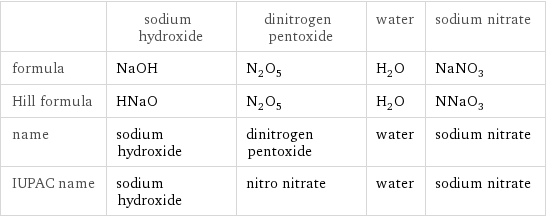
| sodium hydroxide | dinitrogen pentoxide | water | sodium nitrate formula | NaOH | N_2O_5 | H_2O | NaNO_3 Hill formula | HNaO | N_2O_5 | H_2O | NNaO_3 name | sodium hydroxide | dinitrogen pentoxide | water | sodium nitrate IUPAC name | sodium hydroxide | nitro nitrate | water | sodium nitrate
Substance properties
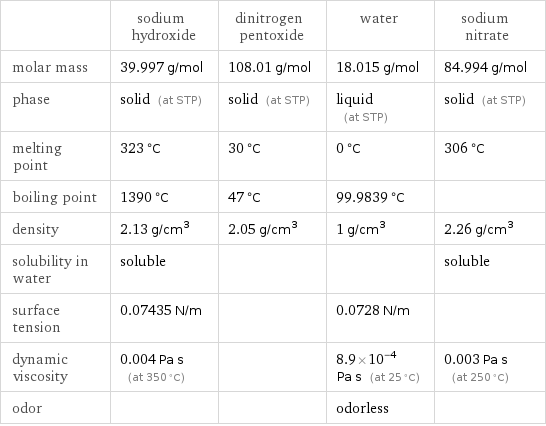
| sodium hydroxide | dinitrogen pentoxide | water | sodium nitrate molar mass | 39.997 g/mol | 108.01 g/mol | 18.015 g/mol | 84.994 g/mol phase | solid (at STP) | solid (at STP) | liquid (at STP) | solid (at STP) melting point | 323 °C | 30 °C | 0 °C | 306 °C boiling point | 1390 °C | 47 °C | 99.9839 °C | density | 2.13 g/cm^3 | 2.05 g/cm^3 | 1 g/cm^3 | 2.26 g/cm^3 solubility in water | soluble | | | soluble surface tension | 0.07435 N/m | | 0.0728 N/m | dynamic viscosity | 0.004 Pa s (at 350 °C) | | 8.9×10^-4 Pa s (at 25 °C) | 0.003 Pa s (at 250 °C) odor | | | odorless |
Units
